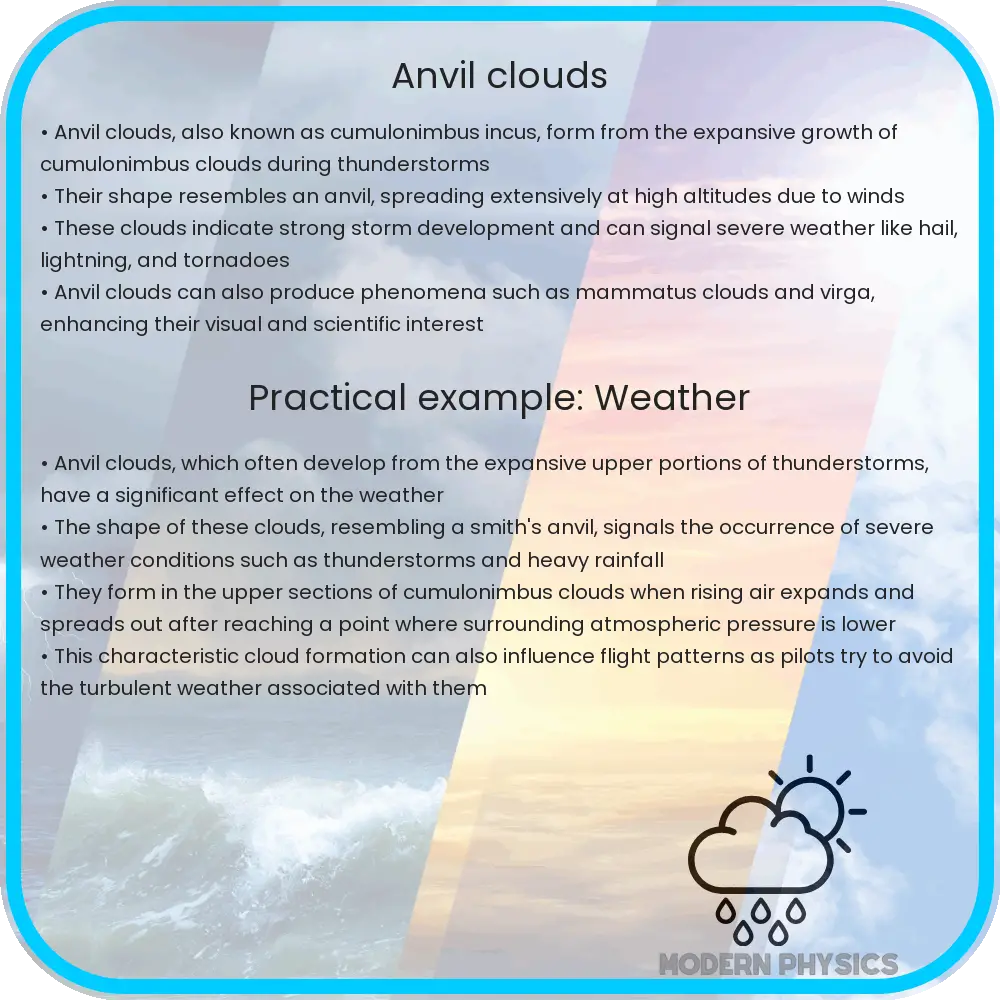An article explaining the formation, characteristics, and impact of anvil clouds, or cumulonimbus incus, which are crucial in predicting weather patterns.

Understanding Anvil Clouds: Formation and Characteristics
Anvil clouds, known scientifically as cumulonimbus incus, are easily recognizable by their distinctive anvil-shaped top, which is often seen during thunderstorms. These clouds play a critical role in the weather patterns and can give clues about the intensity and movement of storms. Understanding how anvil clouds form and their impact can help in better weather prediction and preparedness.
Formation of Anvil Clouds
Anvil clouds are typically formed from cumulonimbus clouds, which are the only cloud type capable of producing thunder, lightning, and severe turbulence. The formation process involves several stages:
- Initial Development: Warm air near the earth’s surface rises due to its buoyancy. This air ascent is usually triggered by intense sun heating or the presence of a front, where two different air masses meet.
- Updraft Formation: As the warm air rises, it cools and condenses forming a cloud. This rising air creates a strong updraft that pushes the top of the cloud higher into the atmosphere.
- Reaching the Tropopause: The updraft continues until it reaches the tropopause, the boundary between the troposphere (where most weather occurs) and the stratosphere. The tropopause acts as a cap, preventing the air from rising further.
- Spread of the Cloud Top: Since the rising air cannot move upward past the tropopause, it spreads out laterally, forming the characteristic flat, anvil-shaped top.
The overall structure and size of an anvil cloud can vary based on the atmospheric conditions such as humidity, air temperature, and the strength of the updraft.
Characteristics of Anvil Clouds
Once formed, anvil clouds exhibit several distinctive features:
- Size: These clouds can become extremely large, sometimes covering hundreds of square miles.
- Height: The height of an anvil cloud can be formidable. While the base may start at about 20,000 feet, the top can stretch up to 75,000 feet in extreme cases, typically found in more severe storms.
- Longevity: Anvil clouds can persist even after the parent thunderstorm has dissipated. This lingering is due to the high altitude and the spread of ice particles within the cloud.
Anvil clouds are not only spectacular to watch but also serve as an indicator of the severity of a thunderstorm. Their presence and direction can help meteorologists predict the movement and intensity of storms.
Impact on Weather Patterns
The influence of anvil clouds on weather patterns is primarily through their role in storm dynamics and longevity. Here are some of the key impacts:
- Lightning: The ice particles within the anvil cloud can contribute to the development of charge separation, which is necessary for the occurrence of lightning.
- Rainfall: Anvil clouds can enhance rainfall by spreading ice crystals over a wider area. When these crystals melt as they fall, they contribute to prolonged and widespread precipitation.
- Air Traffic: Due to their height and turbulence, anvil clouds pose significant challenges to air traffic, requiring rerouting and changes in altitude to ensure passenger safety.
In addition to these impacts, anvil clouds are pivotal in the study of climate change. By understanding how these clouds interact with thermal processes in the atmosphere, scientists can better predict changes in weather patterns and potentially mitigate some of the adverse effects of climate change.
How Anvil Clouds Affect Human Activities
Anvil clouds, apart from influencing weather patterns, also have direct and indirect effects on human activities:
- Agriculture: Farmers rely on accurate weather forecasts for planting and harvesting. The presence of anvil clouds can indicate imminent severe weather, helping farmers take timely actions to protect their crops.
- Outdoor Events: Sports and outdoor events are often subject to delays or cancellations due to the severe weather associated with anvil clouds. Understanding their formation can help in better event planning and risk management.
- Energy Management: Utility companies can use information about anvil cloud development to anticipate changes in weather that affect energy consumption. For instance, increased cloud cover and subsequent cooling can lead to decreased air conditioning use, impacting energy demand forecasts.
Moreover, the impressive visual phenomenon of anvil clouds also draws interest from photographers and storm chasers who seek to capture the beauty and power of nature. This, however, must be pursued with caution due to the dangerous weather conditions these clouds can herald.
Conclusion
Anvil clouds are not only a mesmerizing natural spectacle but also a crucial component of our atmospheric system. Their formation from cumulonimbus clouds under specific atmospheric conditions illustrates the dynamic interplay between the Earth’s surface and the upper layers of the atmosphere. By understanding the characteristics, implications, and impacts of anvil clouds, we can improve weather forecasting, enhance safety protocols for air travel, and refine our responses to potential climate changes.
The study of anvil clouds offers an exciting insight into the power of nature and encourages further exploration in meteorology and climate science. As we continue to unravel the complexities of these formidable cloud formations, we can better prepare for and adapt to the ever-changing patterns of our environment. Equip yourself with knowledge about anvil clouds, and watch the skies with a more informed and appreciative eye.
